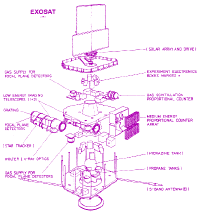The Instruments
Total effective geometric area
Total residual background count rate
Spatial resolution (line spread function HEW)
Average steady residual background
Total effective geometric area
Total residual background rate
Scientific instruments
 Overview
Overview
When the programme was approved, it was decided that, since Exosat was to be used as an observatory by many observers, funding for the instrumentation should be provided by the Agency. Instrument proposals were solicited from the scientific community and a selection made, the final instrument list comprising:
- The grazing incidence telescopes (LE) of 1 m focal length to provide X-ray images within a one degree field-of-view. Each telescope was provided with two imaging detectors, a set of filters for selecting more restrictive wavebands for photometry and a grating spectrometer for high-resolution spectroscopy.
- An array of eight double proportional counters (ME) with a full field-of-view of 1.5° to provide high sensitivity for X-ray source time-variability studies and medium-resolution spectrophotometry. The detectors were mounted on mechanisms such that half the array could be offset by up to 2° for simultaneous off-target background monitoring.
- A gas scintillation proportional counter (GSPC), also with a 1.5° field-of-view to provide higher resolution spectrophotometry.
For the majority of the mission, only one of the two telescopes was used because of detector failures. A mechanical malfunction limited high-resolution spectroscopy measurements using the grating to the first months of operations.
Figure 1. Detailed view
 Vital statistics
Vital statistics
Medium Energy Experiment (ME)
1500 cm2 (all quadrants co-aligned) | |
1 - 20 keV (argon proportional counters) | |
5 - 50 keV (xenon proportional counters) | |
51/sqr (E(keV)) % FWHM (argon counters) | |
45 arcmin FWHM triangular response with a 3' flat top | |
3 cnts/s/keV (2-10) argon counters co-aligned |
Table 1: Summary of the medium energy experiment (ME)
Low Energy Experiment (LE)
Energy range |
0.04 - 2 keV (6 - 300 Å) (*) | ||
5 filters available for broad-band spectroscopy | |||
2.2 deg diameter | |||
0.4 |
2.6 |
-- | |
11.1 |
0.4 |
0.1 | |
4.5 |
3.3 |
0.4 | |
3.2 |
2.5 |
2.0 | |
2.2 |
1.6 |
1.8 | |
0.6 |
0.5 |
0.6 | |
18 arcs | |||
40 arcs | |||
1.8 cnts/s/cm² (LEI) (**) | |||
(*) Subject to UV contamination between 900 and 2 600 Å | |||
(**) Background rate subject to flaring | |||
Table 2. Summary of the low energy experiment (LE)
Gas Scintillation Proportional Counter (GSPC)
150 cm2 | |
2 - 18 keV or 2 - 40 keV, depending on gain setting | |
27/sqr(E(keV)) % FWHM | |
45 arcmin FWHM triangular response with a 3' flat top | |
1.3 cnts/s/keV (2 - 10 keV) |
Table 3. Summary of the gas scintillation proportional counters (GSPC)
 Science teams
Science teams
Instrument |
Institute |
Principal Investigator |
Low-energy imaging telescopes (LE) |
Laboratory for Space Research (Leiden) |
|
Medium-Energy instrument (ME) |
University of Leicester |
|
Gas Scintillation Proportional counter (GSPC): 2-16/2-32 keV |
ESA/SSD |
Table 4. Science teams
 Industrial involvement
Industrial involvement
The final instrument complement was procured under ESA contract, the programme being under the managerial control of Space Science Department at ESTEC. The scientific groups, their responsibilities and the principal contractors involved in the instruments' development programmes are given in the table below.
Low-Energy Imaging Telescopes (LE) | ||
Optics |
SRON, Leiden (NL) |
CIT-Alcatel (F) |
Detectors |
MSSL, London (UK) |
Sira (UK) |
System/Electronics |
Matra (F), SNIAS (F) Laben (I) | |
Gratings, Filters |
SRON, Utrecht (NL) |
|
Medium Energy Experiment (ME) | ||
System and detectors |
Univ. Leicester (UK) |
BAe (UK), LND (US) |
MPE Garching |
Galileo EOC (US) | |
Electronics |
Laben (I), Matra (F) | |
Gas Scintillation Proportional Counter (GSPC) | ||
Detector and System |
SSD, ESTEC |
AEG (D), Electrofusion (US) |
MSSL, London (UK) |
||
Table 5. Principal contractors

